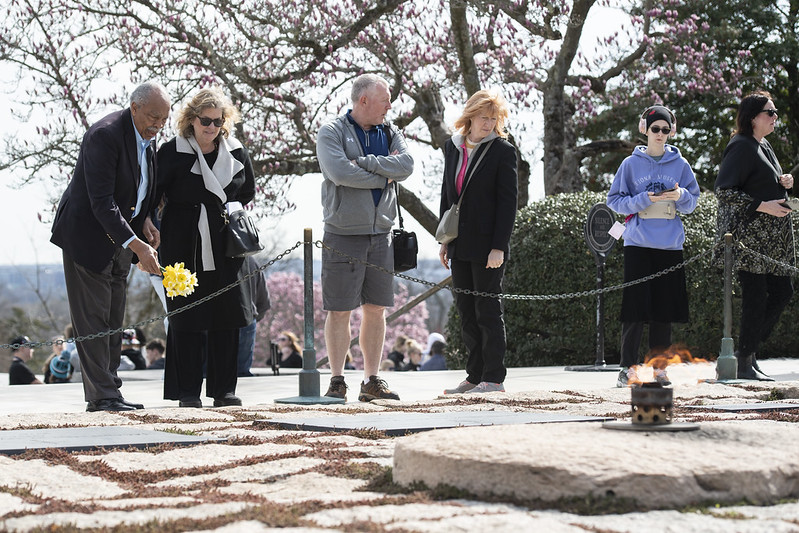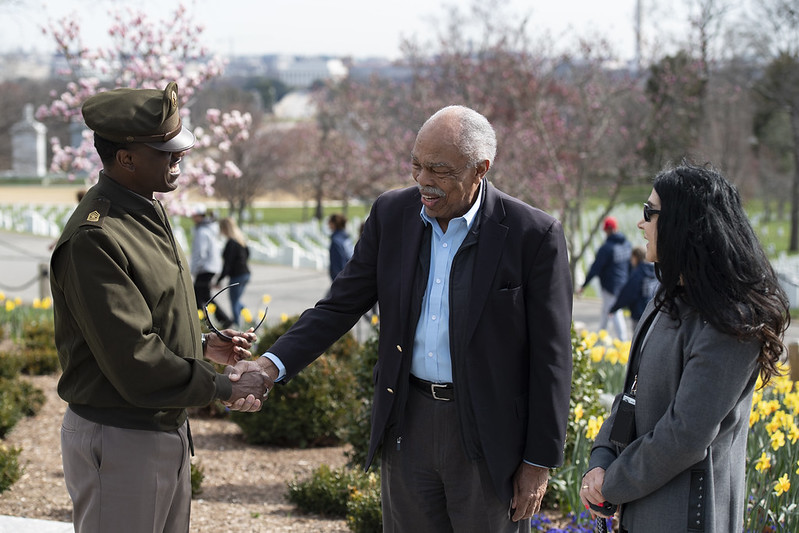
“We came through here,” James Felder said as he stood at the base of President John F. Kennedy’s gravesite at Arlington National Cemetery (ANC), recalling how he helped carry the president’s casket along with seven other military pallbearers up a hill to the burial spot. “The clergy were walking so slow,” he remembered, “and the casket was getting heavier with every step.” Yet Felder and his fellow pallbearers brought the president to his final resting place with the precision and honor expected of a military honor guard.
Felder visited ANC in the spring of 2024, to lay flowers at Kennedy’s grave, walk the grounds, and reflect on his role in the president’s state funeral on Nov. 25, 1963, two days after his assassination in Dallas, Texas. Executive Director of the Office of Army Cemeteries and Army National Military Cemeteries Karen Durham-Aguilera and Senior Enlisted Advisor for the Office of Army Cemeteries and Army National Military Cemeteries Sgt. Maj. Donnie Davis (pictured below) greeted Felder and listened to his recollections of the historic state funeral.

With flowers in hand, Felder walked to Kennedy’s grave. Pointing at some shrubbery, he noted, “that’s where [French President] Charles de Gaulle and [Ethiopian Emperor] Haile Selassie stood together” — two of many foreign dignitaries who attended four days of ceremonies for the slain president.
Felder credits Kennedy for desegregating military honor guards. “I was the tenth Black to serve in the Old Guard,” said Felder, referring to the 3d U.S. Infantry Regiment, “and it was all because of Kennedy.” Yet Felder faced many other forms of racial discrimination: for example, while he worked at the cemetery, he had to live in Washington, D.C., because he could not obtain an apartment in Arlington, Virginia.
For Felder, the president’s funeral service began on Nov. 22, 1963, the day of the President’s assassination, as he and other members of the joint color guard awaited Air Force One on the tarmac at Andrews Air Force Base. Felder was only 23 years old at the time, but he had already performed more than 1,000 funerals at ANC.
After Air Force One touched down, the color guard transferred Kennedy’s casket from the aircraft to an ambulance, which headed to the Naval Medical Center in Bethesda, Maryland. Felder and the other members of the color guard flew there in a helicopter to provide security. “From that point on, for the next four days, the body was never out of my sight,” Felder said. He witnessed the president’s autopsy and his embalming. “Mrs. Kennedy wouldn’t let the body leave the hospital,” he added, “so the embalmers had to bring their equipment to the hospital.”
Kennedy’s casket weighed 800 pounds—and almost 1,000 pounds with the president’s remains inside. The original six-member pallbearer team was increased to eight members. It grew to nine on the morning of Nov. 23, when Lt. Samuel Bird, Felder’s platoon leader, helped lift the casket off the caisson and supported its back as the honor guard carried it up the steps to the U.S. Capitol, where Kennedy would lie in state for the next 20 hours.
The Capitol remained open all night as millions of people filed through to pay their last respects to the slain president. Felder remained the whole time. “I got about eight hours of sleep during that four-day period, he recalled. “I was operating on adrenaline.”
The next day, before escorting the president to his final resting place at ANC, Felder and his team transported the casket to St. Matthew’s Cathedral. When he and his team reached the top step of the cathedral’s entrance, they had to summon “some extra strength” to hold the casket steady while a priest anointed it with holy water and said a prayer.
After the service, as Felder and his team brought the casket back onto the caisson, he noticed First Lady Jacqueline Kennedy and her son, John Jr., standing nearby. “That’s when ‘John John’ did that salute,” said Felder, who knew that the boy had turned three that day. “It brought tears to my eyes.”
Felder and his team then escorted the caisson to Arlington. Felder remembered that they were exhausted by the time they reached the cemetery. Yet, with the world watching their every step on television, the team successfully performed their final walk—uphill, on grass—to convey the president’s casket to its final resting place.
A few weeks after the funeral service, Mrs. Kennedy called Felder to thank him for his role in the service. “She had a very calm, soft voice,” he recalled. She later sent him a letter and photo album of the funeral service. Looking back on her role after her husband’s death, Felder said, “She was only 32 years old, but she was the mastermind behind planning that funeral.”
Felder completed his two years of military service in 1964 and moved back to his hometown, Columbia, South Carolina. He did not return to the cemetery for nearly 20 years, when he attended the 1981 funeral for champion boxer and World War II Army Veteran Joe Louis Barrow.
Felder has since returned to the cemetery several times. Still, he reserved his 2024 visit for honoring the slain president and reflecting on his own role in laying President Kennedy to rest. “It brought back a lot of memories,” he later said.
